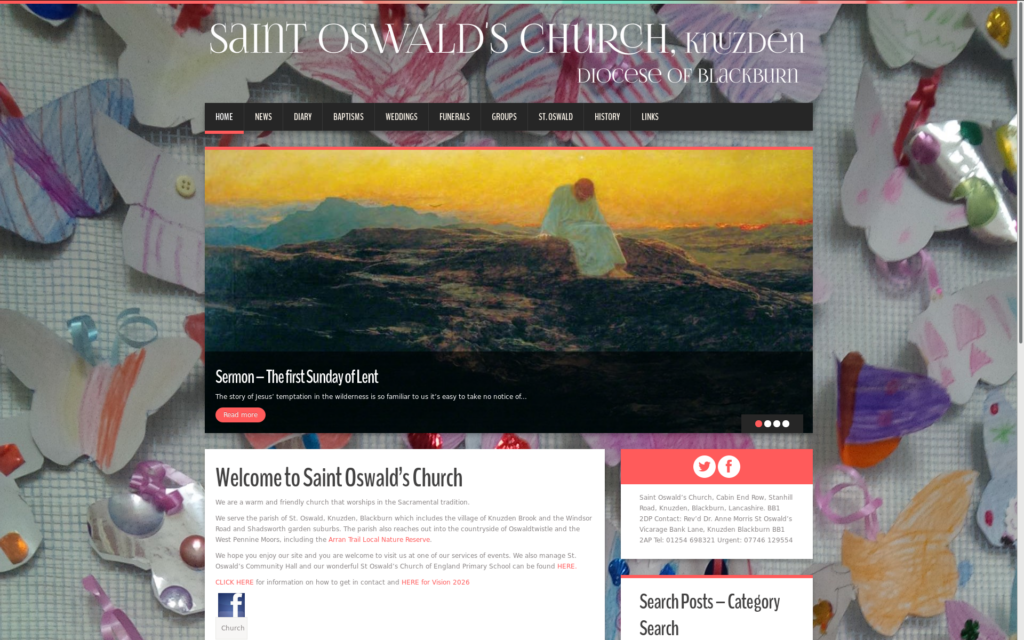This is just a brief wrap up Gingerling Design, including my ethos and motivation for making websites trading under that name. That project is now closed and I don’t do this work anymore following my dads death, however, I learned a lot so good to jot it down!
Table of Contents
Charity sector website burnout
In my long experience of volunteering in the heritage sector and working with church groups, I found that the life cycle of websites usually goes like this:
- Charity pays a lot money for a website on a propriety CMS
- (or a volunteer makes one using convoluted tech)
- Only one or two people have access to publishing on the website because
- The work is difficult
- They’re publishing as the organization so few people allowed to speak on behalf of it
- Those people burn out or don’t have time (or the CMS is defunct)
- The website is out of date. At some point the cycle starts over, content is lost
- I have also come across charities who completely lose access to their site and urls
Open Source: cheap, cheerful and minimal lock-in
My philosophy was to use open source software with lots of free training and support, so I chose WordPress. If I was careful not to use too many plugins and keep the design simple, the CMS would have:
- Minimal vendor lock-in to either
- the hosting company
- myself (the provider)
- the software
- Maximum life span, with updates not being a huge problem
I chose a hosting company (GreenNet) well used to working with charities etc that would minimise the risk of a charity losing access to their website.
I also used auto-posting to push out content to social media; this way the archive of content “belongs” to the organization (not facebook etc).
Finally, I used simple, free themes and just did minimal design tweaks such a colours and logos. All the time went in to the functionality of the site
Did it solve lock in?
This did largely work, though I think some of the older sites didn’t transition to mobile first that well and needed a re-theme. However, when I wrapped up Gingerling Design after my dad died, all my clients websites we’re handed over to new hosting companies and providers without issue. No one was locked out of their site.
Pyramid of publishing power
My approach to the problem of burn out, where only one or two people having access to publishing, was to created a tiered system of publishing rights using the WordPress User Role system. It looked like this:
- 1 Administrator (me) who can edit pages, themes, all the breakable stuff
- Multiple Editors who can publish posts: the posts would populate the pages automatically using categories and tags to send them to the right place. The Editors name would show next to the post.
- A very wide range of Authors who can submit content for review to the editors, the Authors name would show next to the post when published.
Take a church for example:
- Members of the PCC might be Editors, being able to make decisions about what is put on the website. They would get email notifications when a post had been submitted for review.
- Authors could be Sunday school leaders, youth group members, choir leaders and congregation members with volunteer roles (flower and tea rotas etc). They could submit their news to the editors for review.
Did it solve burnout?
In some ways:
- No one ever “broke” a website
- populating pages with posts using tags and categories worked much better than giving people admin access and letting them update the pages constantly.
- Interface was simple
- Restricting what users could see with user roles, the interface of WordPress was simple enough to teach quite a wide variety of people to use it
- I feel like there were very few “power struggles” relating to the website, people didn’t “gate keep”, when perhaps there could have been more with a different set up.
However, in reality, only one or two people ever actually wrote posts for most websites, and these were always editors.
I am not sure why this was, I had really hoped that people would feel empowered to put their own news up, but they never did. Possibly they didn’t want to, or may not have had the confidence in writing for public consumption. I think also there was just a lack of time for people to do this kind of writing, it was never a priority.
Also I think auto-posting to social media didn’t work because the Facebook pages were usually run by different people within the organization and the integrations just kept breaking.
Changing times
The Church of England now has it’s own tool for building websites, called A Church Near You which dealt with some of the issues I was addressing, so I felt that there wasn’t a need for my services so much. Then after my dad died, I didn’t want to work in heritage sector anymore, it was too sad. So I wrapped up the project.
I have kept all my internal documentation, if you would like to see it anytime just send me a comment or message.
That’s a wrap
Here is a selection of the sites I made:









